The AMI StorTrends 3500i is a 3U, 16-bay hybrid storage array that combines the benefits of SSD acceleration and the capacity and pricing benefits of HDDs. The StorTrends 3500i is a dual-controller configuration set to active/passive, each driven by Dual Intel Xeon 2.4GHz E5620 processors and 16GB of memory. The real magic though comes in the control the 3500i offers to customers. The array supports both SSD caching and tiering, which is somewhat novel in the hybrid space, and a feature called Automatically Tuned Volumes (ATV). ATV gives users a high-degree of control over what kind of performance an individual volume receives by selecting the storage it sits on, allowing admins to prioritize (or not) the performance. StorTrends arrays also include a robust set of enterprise-ready data services and the ability to scale up with additional disk enclosures.

The biggest selling point of the 3500i is its availability in both hybrid and full SSD configurations as well as the inclusion of both SSD Caching and Tiering functionality in the same array, which is unique in the hybrid storage market as most only do caching or only tiering. AMI offers a variety of configurations for the 3500i, the typical accelerated configuration using four SSDs for tiering and two for caching. The array supports multiple HDD tiers as well, letting users opt for performance or capacity oriented configurations. Of course with an expansion shelf they could tune for both, taking advantage of capacity and performance HDDs with the rapid flash layer on top. For those that need ever more performance, the 3500i may be configured entirely with flash, forgoing the caching and tiering entirely.
While high-performance storage is certainly compelling, where many arrays fall down is on the data services side. AMI has done well to mitigate much of that concern with the inclusion of a host of enterprise features. These are highlighted by support for snapshots, thin provisioning, replication, WAN data services and archiving with deduplication. The system supports RAID 5, 6, 10, 50 and 60 and is managed via an easy to use web-based GUI. For those who want to take full advantage of the SSDs inside, the StorTrends supports an optional 10GbE card.
Worth noting is StorTrends is the data storage division of AMI, American Megatrends. AMI has been in business since 1985 and has over 1,300 employees worldwide. While not known as a storage leader, they do have nearly 1,200 systems in the field and have been quietly going about their business for the last several years. AMI has very strong balance sheet, which helps both on the innovation and support side, as many buyers have concerns about the viability of the company they’re buying from when taking a step away from the typical Tier 1 storage vendors. They also have a deep history in RAID architecture to go with 114 StorTrends patents, to form a rich technical base.
Our StorTrends 3500i configuration includes SSD cache: 200GB (200GB SSDs x 2 RAID1), SSD tier: 1.6TB usable (800GB SSDs x 4 RAID10) and HDD tier 10TB usable (2TB HDDs x 10 RAID10) and optional 10GbE. This configuration carries a list price of $87,999.
Specifications
- Hardware: StorTrends 3500i Dual Controller SAN
- Form Factor: 3U, 16 bay
- Weight: 96 lbs (43.5 kg)
- Dimensions: 17.2 in x 5.2 in x 25.5 in (437 x 132 x 648 mm)
- Power Supply Redundant: Yes
- Power Supply Hot-swappable: Yes
- Hard Drive Bays: 16
- Hard Drive Interface: NL-SAS, SAS, Solid State Drive (Flash)
- Hot Swappable Hard Drives: Yes
- Drive Configuration Options: Available in Hybrid and Full Flash (SSD) Configurations
- Number of Processors: (4) Intel QuadCore processors with two (2) processors per controller
- Memory: 32 GB (16 GB per controller)
- SSD: 200 GB, 400 GB, 800 GB, 2 TB Solid State Drives (SSD)
- SAS: 300 GB, 450 GB, 600 GB Hard Disk Drives (15000 RPM SAS)
- NL-SAS 1TB, 2 TB, 3 TB, 4 TB Hard Disk Drives (7200 RPM NL-SAS)
- Network Interface Controller: (NIC) Four (4) GbE LAN Ports (2 NICs per controller) with optional 1GbE or 10GbE upgrade
- RAID Support: RAID-RT supporting RAID 5, 6, 10, 50, 60
Design and Build
The AMI StorTrends 3500i is a 3U storage array, housing 16 drive bays that are stacked vertically and enclosed within an all-metal chassis. Each end of the StorTrends 3500i’s front panel has a power button and several status LED indicators, including: power, health and network activity. The sides of the StorTrends 3500i hold inner rack rails, which latch into included sliding rails. As far as drive installation goes, if users have disks shipped separately, they must install the drives in the order as indicated on the top of the chassis. In addition, the drives also have printed labels showing the slot numbers of the hard drives, which is very handy.

The rear panel of the StorTrends 3500i is divided into two sections, with their own controller and power supply. Each controller has three fans and two NIC ports as well as a KVM and SAS port for expansion. Inside, each controller is powered with dual Intel Xeon 2.4GHz E5620 processors with 16GB of memory (total of 32GB).
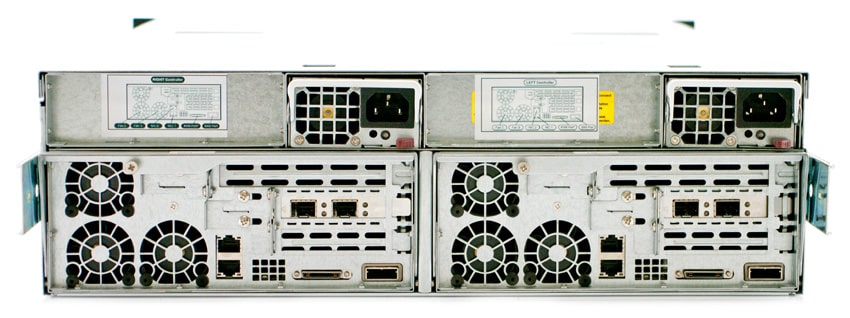
Usability
The StorTrends iTX architecture comes pre-installed on the 3500i, which provides users with a fully-loaded, enterprise-class feature set. Some of this functionality includes intelligent application aware snapshots, auto data tiering, an easy-to-use GUI interface, a VMware vSphere Plugin for ease of management, their Storage Appliance Management ManageTrends web GUI, and a proprietary WAN Optimization engine.
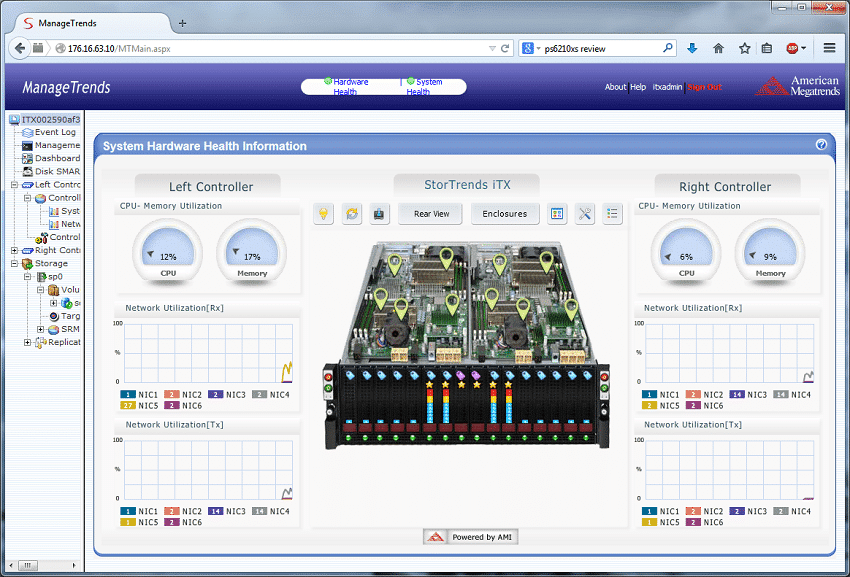
Snapshots are a very useful feature to ensure the reliability of an enterprise’s storage pool and the StorTrends 3500i has no shortage of this type of functionality, featuring a wide range of very useful snapshot technology, including Advanced Snapshots (SnapTrends) and snapshot scheduling, the later allows up to 8,048 read-only and writeable snapshots per appliance with virtually no performance degradation. Redirect on Write (ROW) Snapshot Technology is also used (opposed to the traditional copy-on-write method), which allows the data that was originally linked with the master volume to remain in place; the actual snapshot data activity is significantly reduced as a result. Other snapshot features include instantaneous rollback to any snapshot, snapshot mounting for file recovery, VSS-based backup support for Windows Servers, and backup agents for popular application servers such as Microsoft Exchange Server and Oracle.
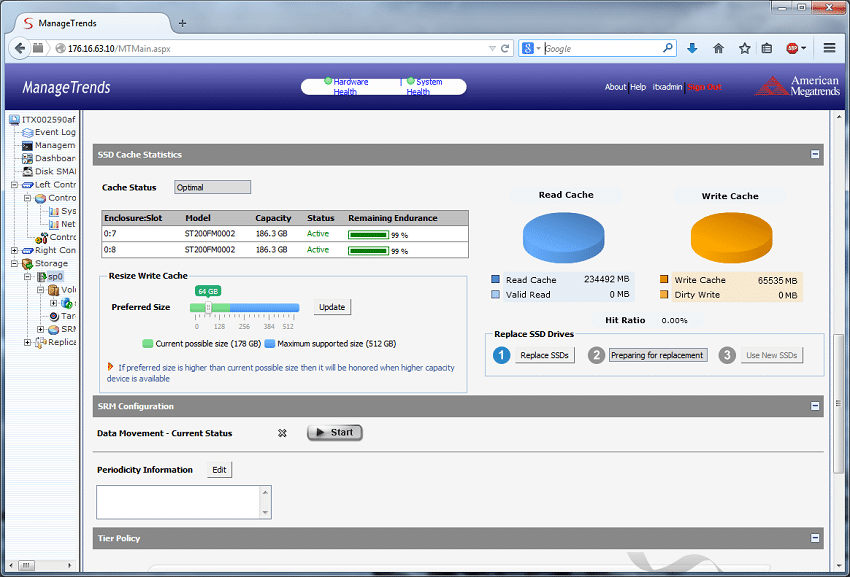
StorTrends iTX also features Snap Assisted Replication (SAR), allowing data to be replicated and stored on multiple StorTrends appliances both locally and at remote sites. The SAR replication module utilizes snapshots, which send only the snapshot deltas to the remote StorTrends array. As a result, this increases network utilization efficiency and decreases bandwidth cost. Further, by enabling the WAN Data Services (WDS), it enables data deduplication, compression, and link optimization to significantly lessen bandwidth and reduce the replication window. SAR also allows for a Data Archive mode on secondary appliance to save space at a DR location.
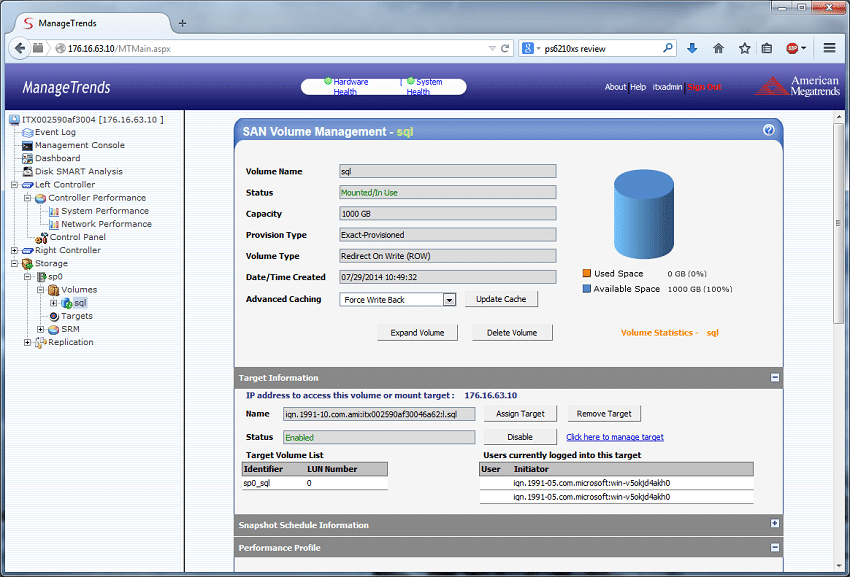
The StorTrends 3500i system resource management software, ManageTrends, is easy to set up and the GUI is very easy to learn and use. When the StorTrends 3500i is up and running, you will see screen with an IP address. If you have both NICs connected to your network, you will see two IP Addresses. Copy IP Address of the 3500i and type it into your Internet browser. You will then be asked to provide a username and password. Once this is done, you will have you have full administrative access and will be taken to the ManageTrends dashboard. If the storage has not been configured on StorTrends 3500i, users will be prompted with the option of using the Quick and Easy Setup Wizard, which will get it up and running in less than five minutes.
Testing Background and Comparables
We publish an inventory of our lab environment, an overview of the lab’s networking capabilities, and other details about our testing protocols so that administrators and those responsible for equipment acquisition can fairly gauge the conditions under which we have achieved the published results. To maintain our independence, none of our reviews are paid for or managed by the manufacturer of equipment we are testing.
We will be comparing the StorTrends 3500i cluster to the X-IO ISE 710, Dell EqualLogic PS6110XS, and Dell EqualLogic PS6210XS.
With each hybrid platform we test, it is very important to understand how each vendor configures the unit for different workloads as well as the networking interface used for testing. The amount of flash used is just as important as the underlying caching or tiering process when it comes to how well it will perform in a given workload. The following list shows the amount of flash and HDD, how much is usable in our specific configuration and what networking interconnects were leveraged:
- AMI StorTrends 3500i
- List price: $87,999
- Flash Cache: 200GB (200GB SSDs x 2 RAID1)
- Flash Tier: 1.6TB usable (800GB SSDs x 4 RAID10)
- HDD: 10TB usable (2TB HDDs x 10 RAID10)
- Network Interconnect: 10GbE iSCSI, 2 x 10GbE Twinax per controller
- HP StoreVirtual 4335 – 3 Nodes
- List price: $41,000 per node, $123,000
- Flash: 1.2TB usable (400GB SSDs x 3 RAID5 per node, network RAID10 across cluster)
- HDD: 10.8TB usable (900GB 10K HDDs x 7 RAID5 per node, network RAID10 across cluster)
- Network Interconnect: 10GbE iSCSI, 1 x 10GbE Twinax per controller
- Dell EqualLogic PS6210XS
- List price: $134,000
- Flash: 4TB usable (800GB SSDs x 7 RAID6)
- HDD: 18TB usable (1.2TB 10K HDDs x 17 RAID6)
- Network Interconnect: 10GbE iSCSI, 2 x 10GbE Twinax per controller
- X-IO ISE 710
- List price: $115,000
- 800GB Flash (200GB SSDs x 10 RAID10)
- 3.6TB HDD (300GB 10K HDD x 30 RAID10)
- Network Interconnect: 8Gb FC, 2 x 8Gb FC per controller
Each of the comparable arrays was also benchmarked with our Lenovo ThinkServer RD630 Testbed:
- 2 x Intel Xeon E5-2690 (2.9GHz, 20MB Cache, 8-cores)
- Intel C602 Chipset
- Memory – 16GB (2 x 8GB) 1333Mhz DDR3 Registered RDIMMs
- Windows Server 2008 R2 SP1 64-bit, Windows Server 2012 Standard, CentOS 6.3 64-Bit
- Boot SSD: 100GB Micron RealSSD P400e
- LSI 9211-4i SAS/SATA 6.0Gb/s HBA (For boot SSDs)
- LSI 9207-8i SAS/SATA 6.0Gb/s HBA (For benchmarking SSDs or HDDs)
- Emulex LightPulse LPe16202 Gen 5 Fibre Channel (8GFC, 16GFC or 10GbE FCoE) PCIe 3.0 Dual-Port CFA
Mellanox SX1036 10/40Gb Ethernet Switch and Hardware
- 36 40GbE Ports (Up to 64 10GbE Ports)
- QSFP splitter cables 40GbE to 4x10GbE
Application Performance Analysis
Our first two benchmarks of the HP StoreVirtual 4335 3-node cluster are the VMware VMmark Virtualization Benchmark and our Microsoft SQL Server OLTP Benchmark which both simulate application workloads similar to those which the StoreVirtual and its comparables are designed to serve.
The StorageReview VMmark protocol utilizes an array of sub-tests based on common virtualization workloads and administrative tasks with results measured using a tile-based unit. Tiles measure the ability of the system to perform a variety of virtual workloads such as cloning and deploying of VMs, automatic VM load balancing across a datacenter, VM live migration (vMotion) and dynamic datastore relocation (storage vMotion). The StorTrends 3500i remained close to the top of the pack during the entirety of the tests, all the way to the 10th tile. The HP StoreVirtual 4335 wasn’t able to reach past the 8-tile mark.
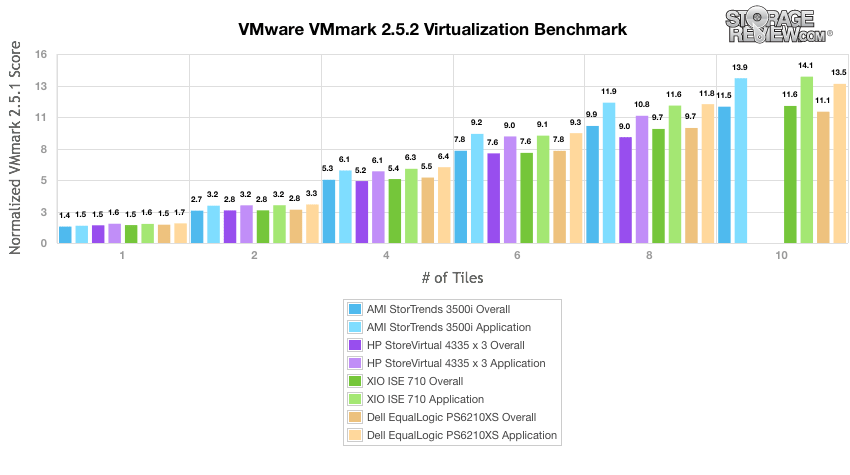
StorageReview’s Microsoft SQL Server OLTP testing protocol employs the current draft of the Transaction Processing Performance Council’s Benchmark C (TPC-C), an online transaction processing benchmark that simulates the activities found in complex application environments. The TPC-C benchmark comes closer than synthetic performance benchmarks to gauging the performance strengths and bottlenecks of storage infrastructure in database environments. Our SQL Server protocol uses a 685GB (3,000 scale) SQL Server database and measures the transactional performance and latency under a load of 30,000 virtual users and then again with a half-size database of 15,000 virtual users.
During a load of 15k virtual users, the StorTrends 3500i was the top performer, posting 3,152.2TPS, just above the XIO ISE 710.
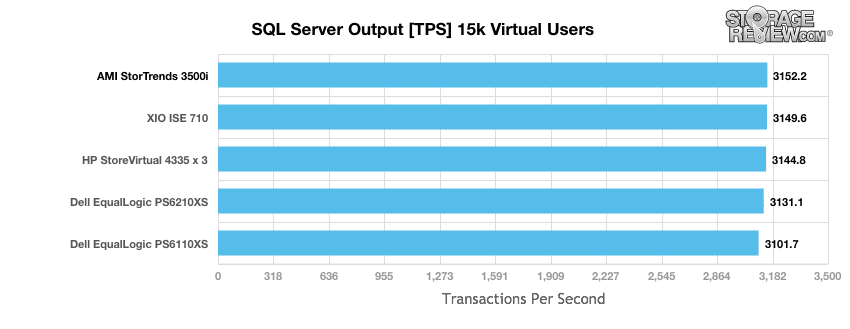
When looking at the average latencies, we see a spread across the board with 15k virtual users. The gap was the narrowest between the top two performers, which were the StorTrends 3500i (with 15ms) and the XIO 710 (with 19ms), respectively. The last three performers show quite a large gap between them, with the Dell EqualLogic PS6110XS situated at the bottom of the pack.
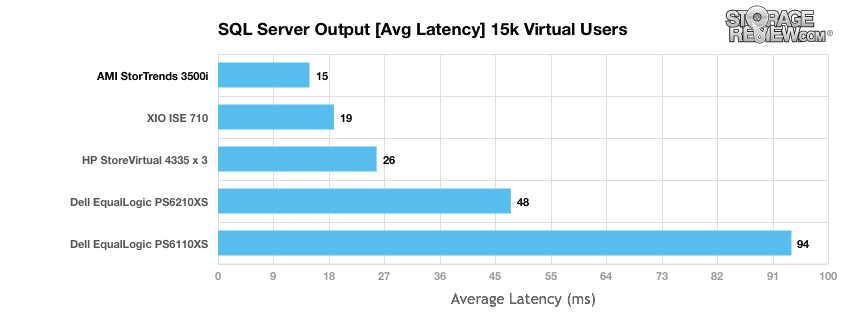
When increasing the workload to 30,000 virtual users, the StorTrends 3500i continued its great performance with a top-performing 6272.4TPS, beating the XIO 710 and Dell EqualLogic PS6210XS (6,153.1TPS and 6,135.5TPS, respectively). The Dell EqualLogic PS6110XS was the slowest array, which posted 5,794.1TPS.
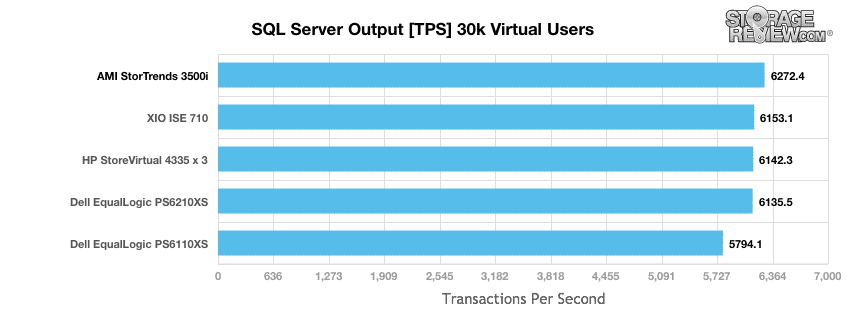
The results of the average latency benchmark told a similar story with the StorTrends 3500i taking top spot by a significant margin with only 41ms; the XIO 710 and HP StoreVirtual 4335 took second and third place with 133ms and 142ms respectively. The Dell EqualLogic PS6110XS was the slowest in the group.
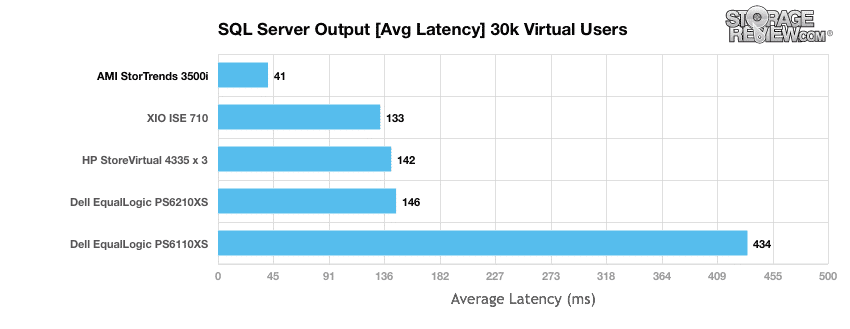
Enterprise Synthetic Workload Analysis
Prior to initiating each of the fio synthetic benchmarks, our lab preconditions the device into steady-state under a heavy load of 16 threads with an outstanding queue of 16 per thread. Then the storage is tested in set intervals with multiple thread/queue depth profiles to show performance under light and heavy usage.
Preconditioning and Primary Steady-State Tests:
- Throughput (Read+Write IOPS Aggregated)
- Average Latency (Read+Write Latency Averaged Together)
- Max Latency (Peak Read or Write Latency)
- Latency Standard Deviation (Read+Write Standard Deviation Averaged Together)
This synthetic analysis incorporates two profiles which are widely used in manufacturer specifications and benchmarks:
- 4k – 100% Read and 100% Write
- 8k – 70% Read/30% Write
Our first benchmark measures the performance of random 4k transfers comprised of 100% write and 100% read activity. During the six hour preconditioning period we verified the data we were measuring was fully tiered on the SSDs to show optimal performance out of the array when configured as eight LUNs. The StorTrends 3500i posted the top write performance at 43,420 IOPS, though it slowed down significantly in the read column taking third place. The highest read performer was the HP StoreVirtual 4335 with 141,141 IOPS.
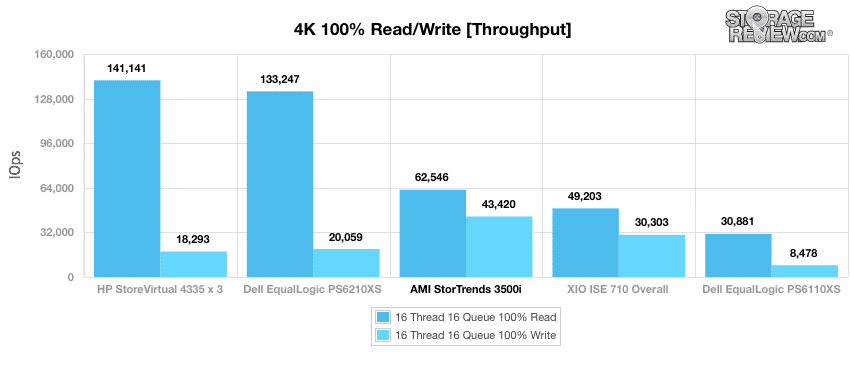
In our average latency tests, the StorTrends 3500i posted the fastest write performance once again, with the XIO ISE 710 being the only comparable coming close. The fastest read performance was recorded by the HP StoreVirtual 4335.
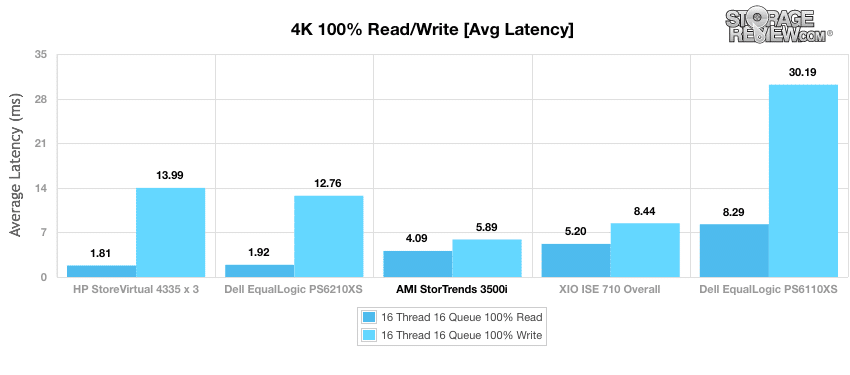
The StorTrends 3500i took first place in write performance in terms of max latency with 142.1ms; however, it fell back some in the read column. The XIO ISE 710 posted the best read results at 51.9ms with the StoreVirtual 4335 taking the second-best spot at 96.5ms; however, the latter had the slowest write performance at 516.1ms.
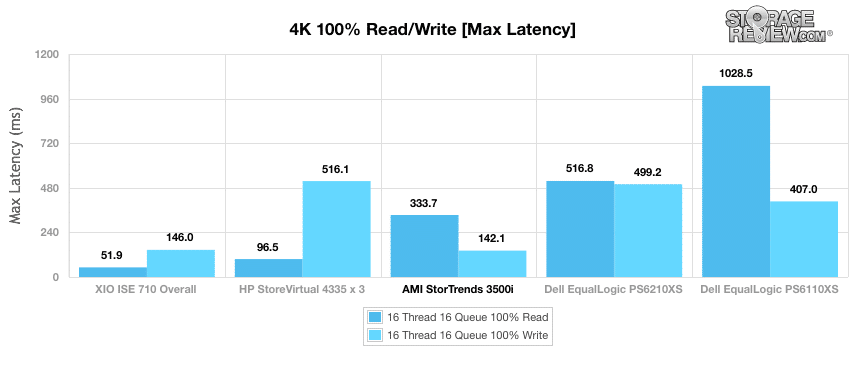
The StorTrends 3500i had the most consistent write performance at 3.5ms in our standard deviation tests, but showed less consistency in read performance (3.6ms). The HP StoreVirtual 4335 boasted the best read function consistency, posting 0.93ms.
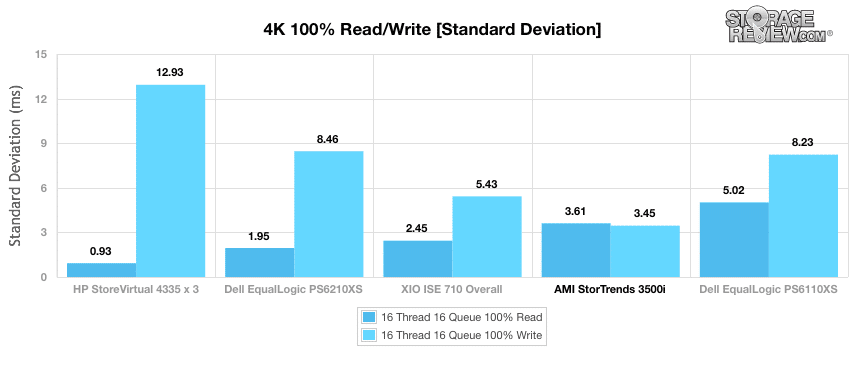
Moving on to our 70% read 30% write random workload, the StorTrends 3500i was the top performer by a noticeable margin, however it required higher queue depths show its performance capabilities. The aging Dell EqualLogic PS6110XS was slowest performer, though that was expected.
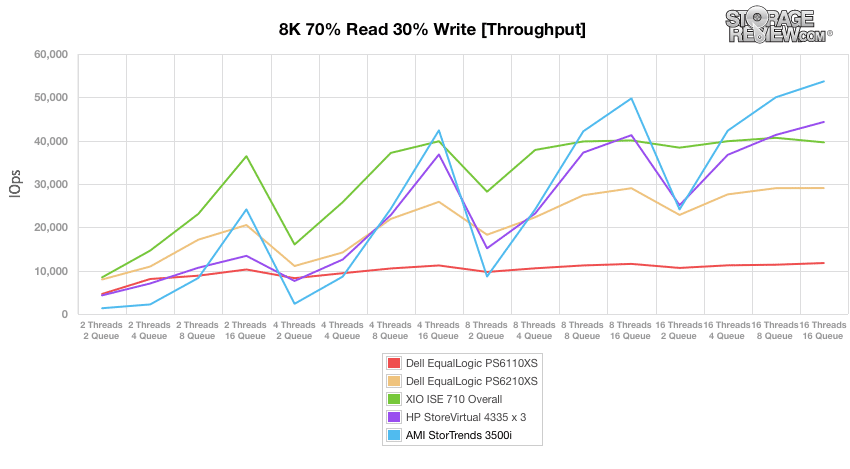
In our average latency tests, the StorTrends 3500i was the fastest device by 16T/16Q, though it started off at the bottom of the pack during initial readings.
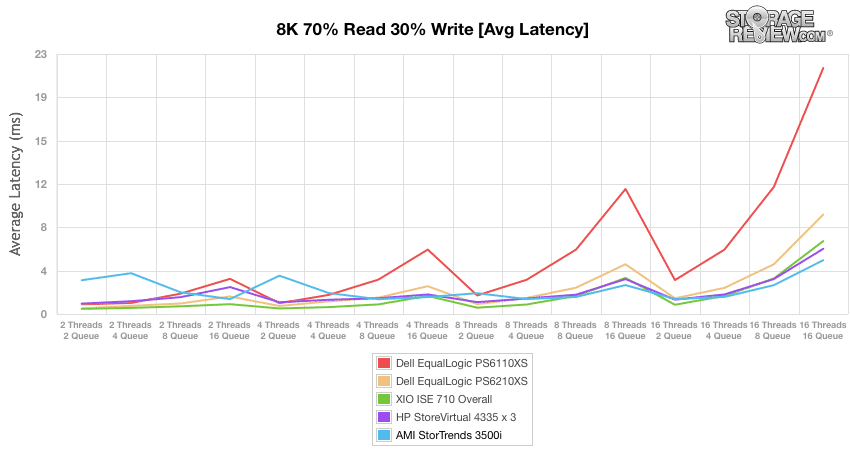
The results of the maximum latency tests showed dominance by the StorTrends 3500i and this time from the get go, barely showing any spikes in latency throughout the entire benchmark. Though it had one, huge latency spike, the XIO 710 took second place.
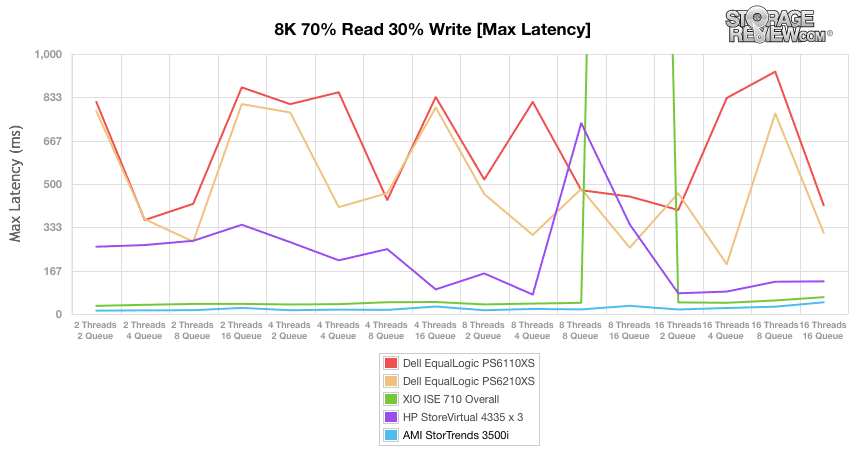
The standard deviation benchmark told a similar story. The StorTrends 3500i once again took top spot, starting incredibly strong with 0.2ms and ending with 3.42ms. The XIO 710 was close behind, however, taking second place with 3.94ms at the last queue depth. The StoreVirtual 4335 also finished strong.
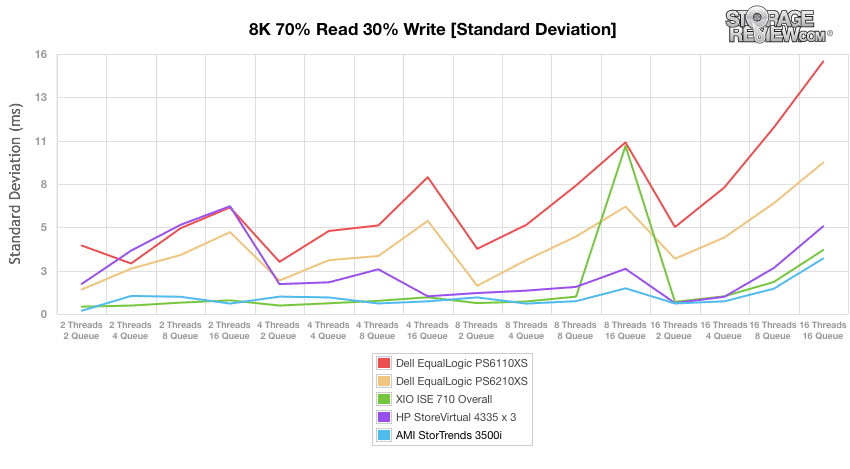
Conclusion
The AMI StorTrends 3500i provides businesses with a powerful and easy to deploy 3U hybrid storage platform built for high performance and maximum capacity. The StorTrends 3500i is equipped with 16 bays, which can be set up in a variety of hybrid configurations; or an all-flash array with 16 SSDs. The dual-controller system includes 4 GbE LAN Ports (2 NICs per controller) with optional 1GbE or 10GbE upgrade, which makes for a worthy upgrade in environments that can support it. As for data services, the StorTrends 3500i comes with a fully-loaded, enterprise-class feature set that’s included in the unit pricing.
It didn’t take long for the StorTrends 3500i to demonstrate its top-class performance during our benchmarking. In the first application test, which measured performance with VMmark, the StorTrends 3500i posted excellent results. The StorTrends 3500i cluster was the at or near the top of the pack, slipping ever so slightly at the 10th tile. In the 15k and 30k virtual-user SQL Server benchmark, the 3500i was easily the best of the bunch especially when measuring the average latency. The 3500i recorded only 41ms latency during 30k virtual users benchmark where the second place system posted 133ms; a significant gap in responsiveness.
Though the StorTrends 3500i was the top performer in write speeds during in synthetic 4k random transfer workloads, AMI’s hybrid array only posted middle-of-the-run results in read performance throughput the benchmarks. That said, it quickly regained its top-tier performance in 8k random mixed workloads tests, with the StorTrends 3500i taking top spot in all benchmarks. This was the most profound in IO, where it boasted almost 10,000 more IOPS than the next array by 16T/16Q.
The StorTrends 3500i is able to achieve all of these impressive numbers for a variety of reasons, one of the biggest being how they handle flash. First off, the array offers both caching (a copy of the hot data on SSDs) and tiering (a permanent location of hot data on SSDs), which is relatively rare among the hybrid storage array vendors. Most provide one or the other, which certainly adds to top-line performance, but as we see here, there can be a benefit to using both. AMI is also using higher capacity SSDs for tiering, at 4x800GB in RAID10, 1.6TB usable in a 16-bay system is well above what many competitive systems offer. The drives are also modern, many of the large storage vendors are using SSD technology that’s very stable but a few years older. The only thing really working against the 3500i is lack of awareness in a crowded market; that likely won’t last long though as the 3500i really shines.
Pros
- Excellent overall performance
- Caching and tiering functionality
- Competitive pricing
- Large company behind the StorTrends products
Cons
- Read speeds slowed down during 4K random transfer workloads
Bottom Line
The AMI StorTrends 3500i hybrid array brings SSD caching and tiering to market in a dual-controller, 3U, 16-bay chassis. The 3500i excelled just about everywhere, creating new performance standards for the hybrid category letting it stand out in a crowded field.
Discuss This Review




 Amazon
Amazon